Organizations deploy edge server systems to run workloads with predictable latency, easy serviceability, and room to grow, and Supermicro’s SYS-E403-14B-FRN2T fits that profile neatly. This short-depth system delivers a feature set designed for walls, closets, and shallow racks, with a specific focus on on-premises AI inference, video analytics, IoT, and multi-access edge computing. Out of the box, it offers three PCIe Gen5 x16 FHFL slots, dual 10GbE ports, and a straightforward storage layout with hot-swap NVMe bays at the front, complemented by fixed SATA bays internally.
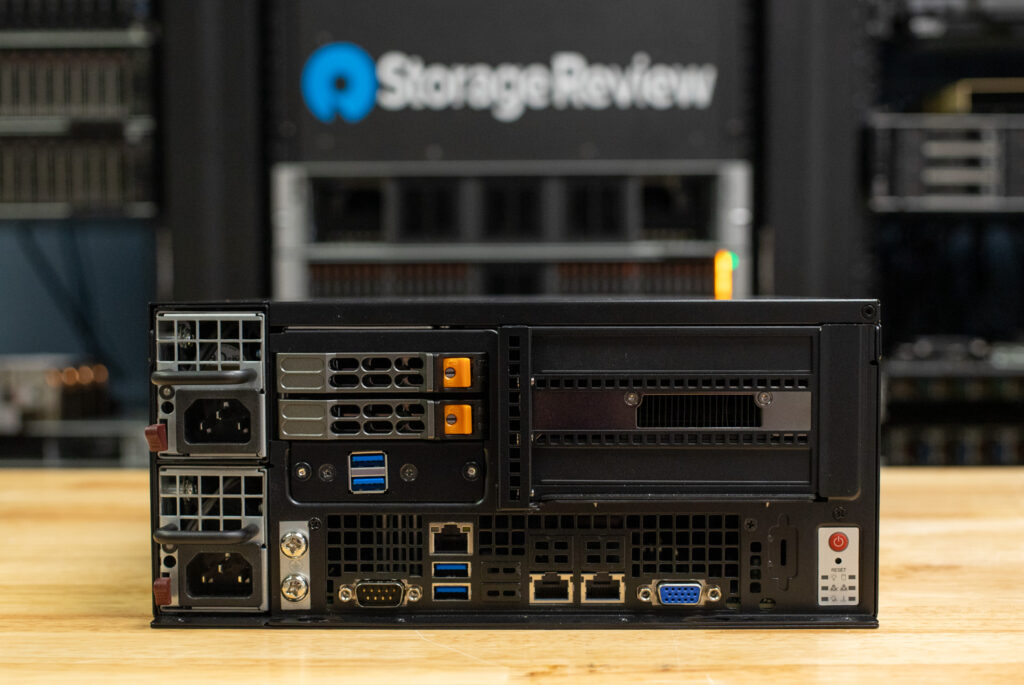
The SYS-E403-14B-FRN2T supports Intel’s Xeon 6 processors in both P-core and E-core families, giving it flexibility that most short-depth systems do not offer. P-core models can reach up to 48 cores and 96 threads, with 288MB of cache, and are designed for latency-sensitive work, such as inference, video analytics, or transactional processing, where high clock speed is crucial. E-core parts significantly enhance core counts, providing up to 144 cores and 144 threads along with 108MB of cache. This makes them more suitable for streaming data, parallel aggregation, or container-heavy deployments. Having both options in the same platform allows operators to decide whether their edge node should emphasize responsiveness or raw density without being locked into lower-power SKUs.
The ability to support CPUs with a TDP of up to 300W on air cooling brings even more flexibility to the SYS-E403-14B-FRN2T. Most edge platforms stop at 165–185W, which locks out top-bin parts. By providing the thermal headroom for 300W, Supermicro enables the deployment of processors that are typically reserved for data center racks. For workloads such as complex inference or heavier AI pipelines, this matters because it removes the artificial limits that often constrain edge servers.
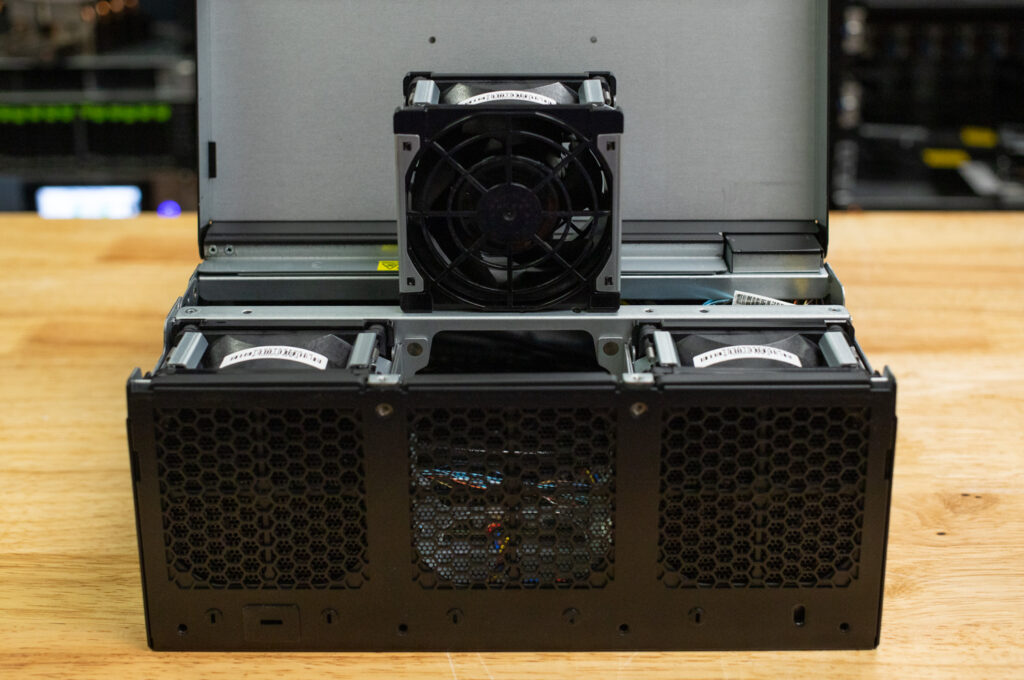
The motherboard features eight DDR5 RDIMM slots, supporting up to 2TB of memory at speeds of up to DDR5-6400 MT/s. A lean build might only utilize 128GB or 256GB of RAM, which is sufficient for lighter inference workloads. However, the same chassis can be scaled up to 2TB for larger analytics nodes that require entire datasets in memory to maintain predictable latency. It means organizations do not need a different platform as workloads grow; they can scale inside the same box. This aligns with how edge environments evolve: starting small and then expanding as applications and data pipelines become more complex.
The chassis also supports either one double-width or two single-width GPUs, making a dual NVIDIA L4 configuration a supported option for edge deployments. That setup reflects one of the most common requests we see from teams moving trained models from data centers to production sites. It strikes a balance between throughput and efficiency, keeping power and thermals under control while maintaining predictable latency. With three FHFL PCIe slots available, there is still room for expansion, whether for ingest or networking, even in a dual-GPU build.
For storage, the system offers two front-access U.2 NVMe bays that support hot-swap functionality and can be populated with enterprise drives as large as 122.88TB each. This means just a pair of SSDs can hold massive local datasets while still leaving plenty of headroom. Two internal 2.5-inch SATA bays provide additional space for operating systems or lighter workloads, and dual PCIe Gen5 M.2 slots add flexibility for fast boot drives or temporary scratch volumes. Together, these options provide a balance of capacity, performance, and serviceability.
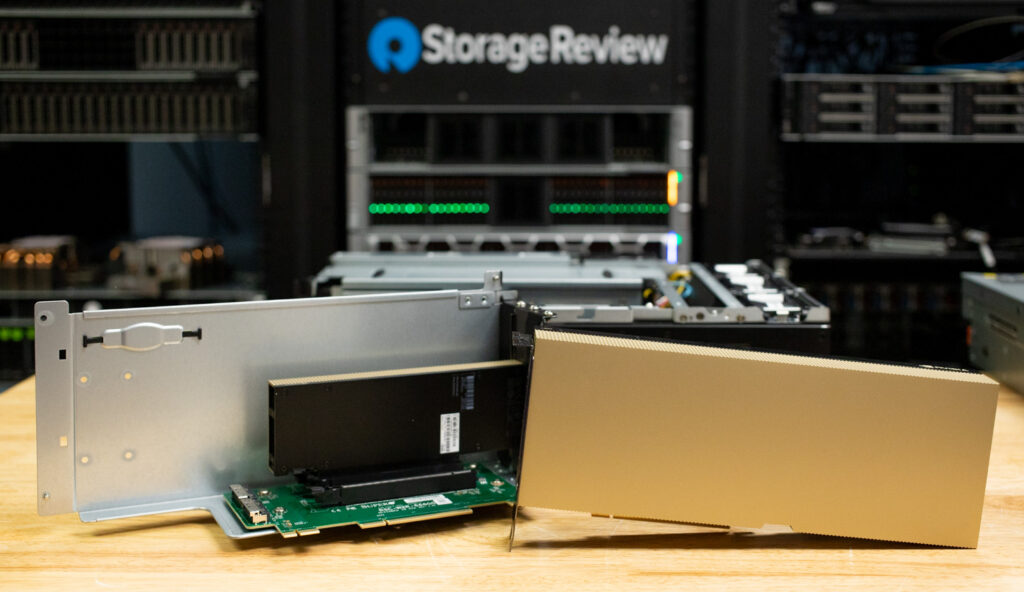
A dedicated ASPEED AST2600 BMC with its own 1GbE port provides complete out-of-band control, including IPMI and remote KVM, allowing administrators to manage the system without affecting production traffic. Security is anchored in hardware with TPM 2.0 and silicon root of trust, backed by signed firmware, secure boot, automatic recovery, and system lockdown features. These measures are particularly relevant at the edge, where physical access can be challenging to control, and they help ensure the system remains trustworthy even in less secure environments.
In our lab, the system has already shown that for its size, it delivers a remarkable amount of usable performance per square inch. The combination of CPU flexibility, high-capacity DDR5 memory, practical acceleration, and straightforward storage makes the SYS-E403-14B-FRN2T feel less like a cut-down edge box and more like a condensed data center node.
Supermicro SYS-E403-14B-FRN2T Specifications
The following table provides a detailed breakdown of the hardware, chassis, and management features of the Supermicro SYS-E403-14B-FRN2T. It covers everything from CPU and GPU support to memory capacity, I/O options, expansion, storage, cooling, and power, giving a complete view of the system’s capabilities in a compact edge form factor.
| Category | Specification |
| Product SKU | SuperServer SYS-E403-14B-FRN2T |
| Motherboard | Super X14SBW-TF |
| Processor | Single Socket E2 (LGA-4710), Intel® Xeon® 6700/6500 series (P-cores) or 6700 series (E-cores) P-cores: 48C/96T, 288MB Cache E-cores: 144C/144T, 108MB Cache Supports up to 300W TDP CPUs (Air Cooled) |
| GPU Support | Up to 1 double-width or 2 single-width GPUs Supported GPUs: NVIDIA L40, RTX 6000 Ada, L4, A2 |
| Memory | 8 DIMM slots, up to 2TB DDR5-6400 MT/s ECC DDR5 RDIMM (1DPC), 1.1V |
| On-Board Devices | Chipset: SoC Networking: 2 × RJ45 10GBASE-T (Intel® X550), 1 × RJ45 1GbE (ASPEED AST2600) |
| I/O Ports | LAN: 1 × RJ45 1GbE BMC, 2 × RJ45 10GbE USB: 4 × USB 3.2 Gen 1 Type-A (Front) Video: 1 × VGA (Front) Serial: 1 × COM (Front) TPM: 1 × TPM Header |
| BIOS | AMI 32MB SPI Flash EEPROM |
| Management | Supermicro Server Manager (SSM), SuperDoctor® 5, Super Diagnostics Offline (SDO), Thin-Agent Service (TAS), SuperServer Automation Assistant (SAA) |
| Security | TPM 2.0, Silicon Root of Trust (NIST 800-193), Cryptographically Signed Firmware, Secure Boot, Secure Firmware Updates, Automatic Firmware Recovery, System Lockdown |
| Chassis | Fan-based Embedded, Model: CSE-E403BiF-000NDBP2 |
| Dimensions / Weight | Height: 4.62″ (117.3 mm) Width: 10.5″ (266.7 mm) Depth: 16″ (406.4 mm) Package: 10.4″(H) × 16.4″(W) × 26″(D) Net: 18.5 lbs (8.16 kg), Gross: 24.5 lbs (10.95 kg) |
| Front Panel | LEDs: HDD, LAN1, LAN2, Power, Reset, System Info Buttons: Power On/Off, Reset |
| Expansion | 3 × PCIe 5.0 x16 FHFL slots |
| Drive Bays | 4 total 2 × front hot-swap 2.5″ NVMe 2 × internal fixed 2.5″ SATA (requires controller/cables) 2 × M.2 PCIe 5.0 x2 NVMe (2280/22110) |
| Cooling | Up to 3 × 80×80×38mm heavy-duty fans with optimal fan speed control 1 × Air Shroud |
| Power Supply | 2 × 800W Redundant Platinum-level (94%) PSU Input: 100-127Vac (750W) / 200-240Vac (800W) / 230-240Vdc (800W) +12V: Max 66.6A 5VSB: Max 4A |
| Operating Environment | Temp (operating): 0°C–45°C Temp (non-operating): -40°C–70°C Humidity (operating): 8%–90% non-condensing Humidity (non-operating): 5%–95% non-condensing |
Supermicro SYS-E403-14B-FRN2T Design and Build
The physical design of the SYS-E403-14B-FRN2T is clean and clearly built around serviceability. The front panel integrates storage, I/O, and system controls in a way that minimizes the need for rear access, which is often limited in wall-mounted or shallow-rack deployments. Two 2.5-inch NVMe bays are located on the left side, making drive swaps straightforward. To the right, three PCIe 5.0 x16 FHFL, front-accessible via risers., providing front-facing access for accelerators or networking cards without requiring extra clearance at the rear.
Connectivity is consolidated across the front, which includes a VGA port, a serial COM port, four USB 3.2 Gen 1 Type-A ports, dual 10GbE ports powered by Intel’s X550 controller, and a dedicated 1GbE management port tied to the AST2600 BMC, all within easy reach. This approach removes the common pain point of servicing edge servers in tight spaces, as virtually every essential interface is available from a single face of the chassis.
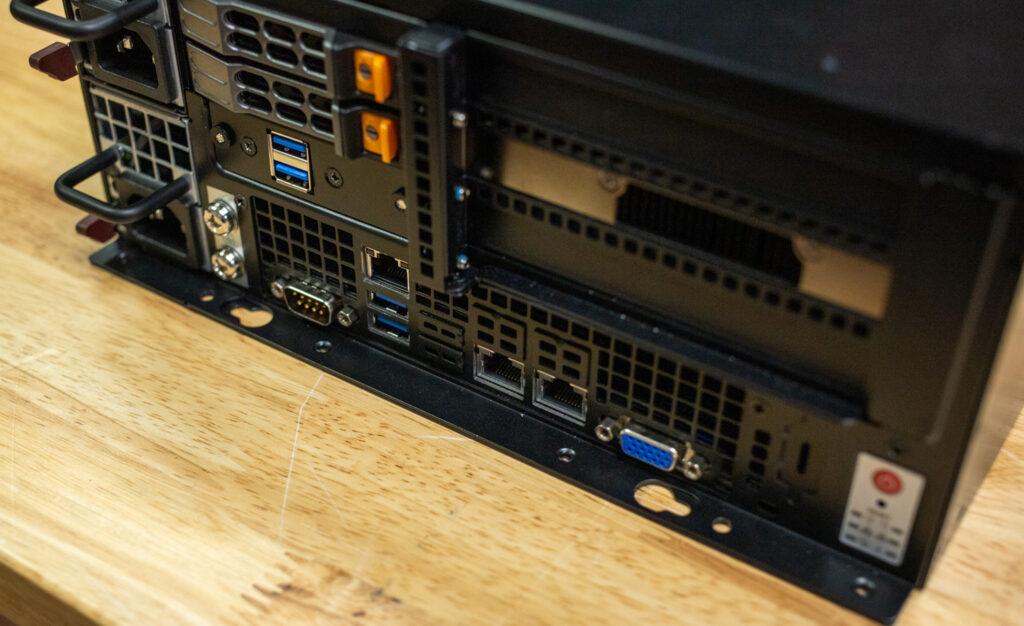
The SYS-E403-14B-FRN2T also features a pair of redundant 800W platinum-rated modules positioned at the top left, each equipped with a handle for quick replacement. On the opposite corner, the control cluster is arranged with a large illuminated power button, a recessed reset switch, and a whole row of status LEDs. Indicators cover power, drive activity, network traffic on both 10GbE ports, PSU failure, and thermal conditions. The dedicated power fail LED tied to the redundant PSU modules is particularly useful, giving technicians instant confirmation of a failed unit so it can be swapped without diagnostic delay. The network LEDs serve a similar role, offering immediate feedback on link activity without the need to check software tools.
There are no additional I/O connectors at the rear, which makes sense for a system intended to be serviced and connected entirely from the front. The chassis is designed with airflow in mind, featuring three 80mm hot-swap fans that span its width, each protected by a removable dust filter. Air enters from the front, moves directly across the CPU and memory, and is expelled at the back in a straight path that avoids unnecessary turbulence. This linear cooling strategy is crucial when higher-power CPUs or GPUs are installed, as it maintains consistent airflow and predictable thermal performance under load.
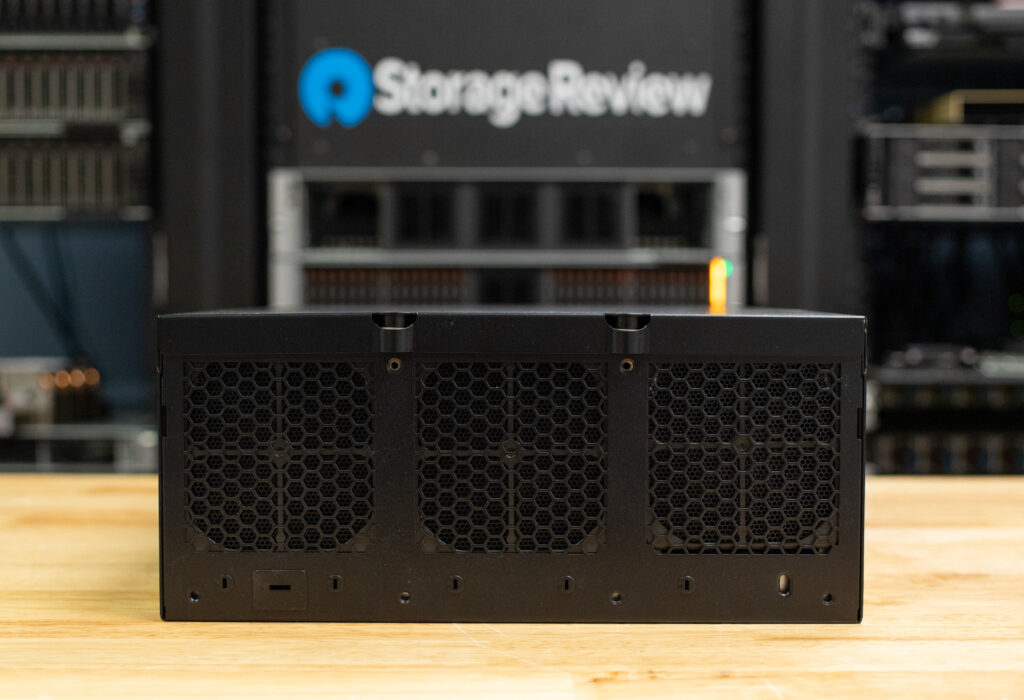
The SYS-E403-14B-FRN2T also features dust filtration since edge deployments are more likely to operate in environments with airborne particles that can compromise performance over time. The filters are designed for easy service and can be removed and cleaned without shutting down the system, keeping the maintenance process simple while reducing the risk of unplanned downtime. By combining hot-swap fans with tool-less, serviceable filtration, the SYS-E403-14B-FRN2T definitely addresses the realities of operating outside the controlled conditions of a data center.
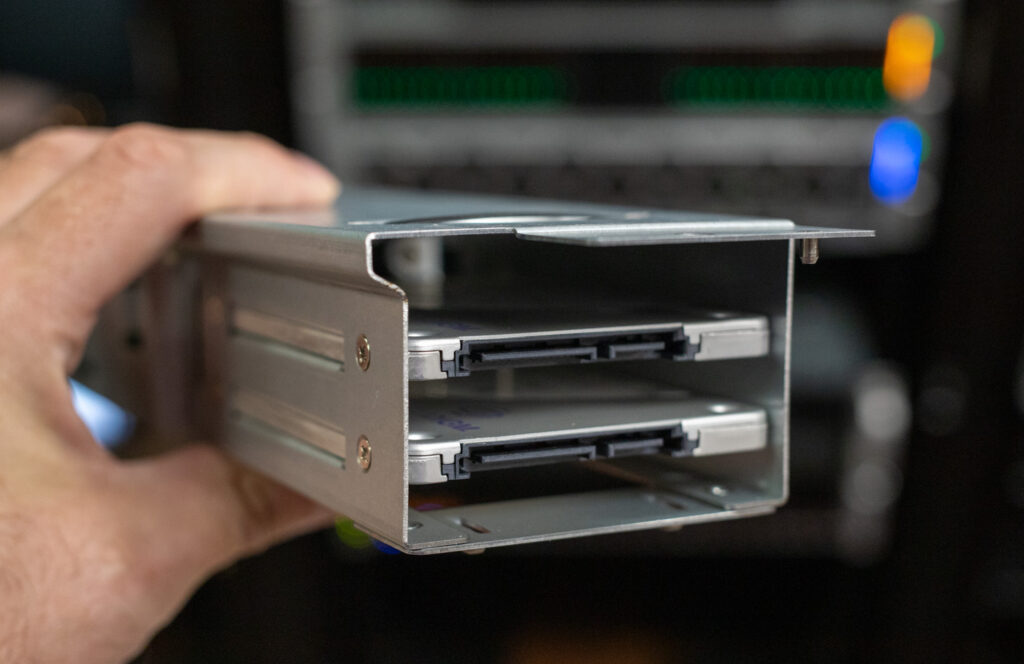
Removing the top cover reveals the main system board, with the DIMM slots arranged neatly alongside the CPU socket, providing clear access for upgrades or replacements. The two internal SATA bays are positioned to the side of the board, while the M.2 slots are arranged so that they can be reached without interfering with the PCIe risers. Expansion is supported by full-height, full-length slots mounted to risers, a layout that preserves the chassis’s short depth while still accommodating larger cards. Power delivery runs vertically along the side through the redundant PSU modules, and the modular design of the units keeps cabling clean and maintenance straightforward.
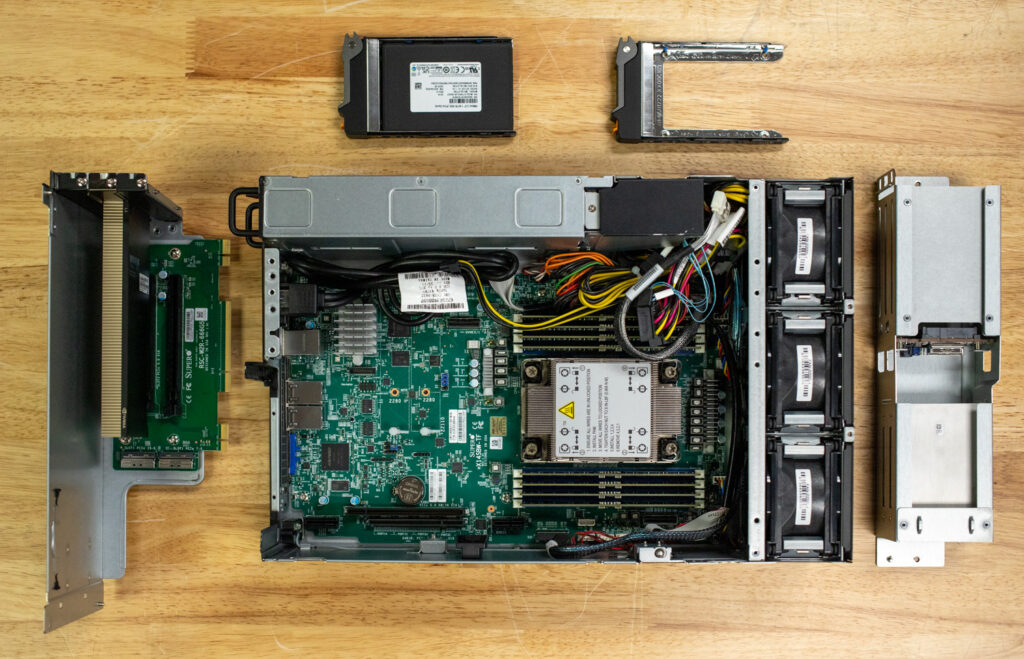
Cooling components are laid out with similar attention to serviceability. The air shroud directs flow evenly across the CPU, while the DIMM arrangement ensures that memory receives consistent cooling without disrupting airflow to the accelerators. GPUs and other add-in cards are positioned so that they benefit from the same channel without creating hot spots around the processor. The separation of service points further simplifies upkeep: drives can be accessed from the front, fans from the rear, and memory or accelerators from the top. In distributed edge environments where access is often limited and maintenance windows are short, this approach prioritizes function and reliability over cosmetic design, making the system easier to maintain and keep in operation.
Supermicro SYS-E403-14B-FRN2T Performance Testing
Before diving into performance benchmarks, it is worth noting that the Supermicro SYS-E403-14B-FRN2T is a thoroughly unique type of system compared to the full-size rackmount servers we typically test. Designed as a compact edge platform, this unit is configured with a single Intel Xeon 6521P processor, providing a total of 24 cores.
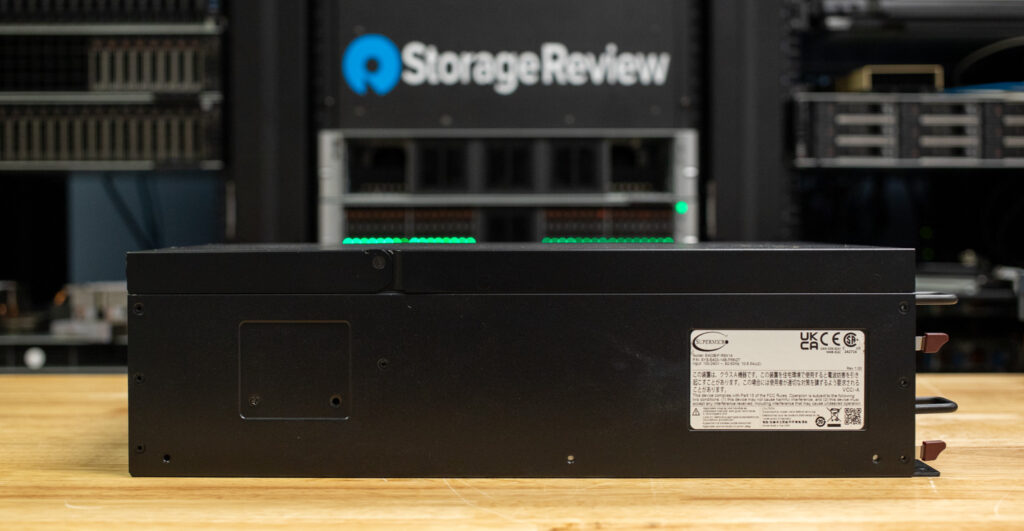
The system supports the latest single-socket E2 (LGA-4710) Xeon 6700/6500 series processors, offering configurations of up to:
- P-cores: 48C/96T with 288MB cache
- E-cores: 144C/144T with 108MB cache
Server Configuration
- CPU: Intel Xeon 6521P 24 Cores
- RAM: 256GB RAM 32GBx8 DDR5-6400 ECC RDIMM
- STORAGE: 2 x Solidigm D3 S4620 960GB and 1x Samsung PM9A3 1.9TB NVMe U.2
- GPU: NVIDIA L4
As we progress through the benchmarks, it’s essential to note that this review focuses exclusively on the Supermicro SYS-E403-14B-FRN2T. We did not have other systems in its exact class available for a fair, like-for-like comparison. The results, therefore, stand on their own, highlighting what this compact edge platform can deliver across a variety of workloads. That said, the system is designed to scale with more powerful configurations, supporting up to 96 P-cores or 144 E-cores, allowing it to move beyond its weight class and approach the performance territory of larger rack-mount single-socket designs.
y-cruncher
y-cruncher is a multithreaded, scalable program that can compute Pi and other mathematical constants to trillions of digits. Since its launch in 2009, it has become a popular benchmarking and stress-testing application for overclockers and hardware enthusiasts.
For y-cruncher testing, the Supermicro SYS-E403-14B-FRN2T, equipped with an Intel Xeon 6521P (24 cores), delivered consistent performance across runs. At the 1 billion digit calculation, it completed in 10.2 seconds, scaling to 27.6 seconds at 2.5 billion digits, 63.1 seconds at 5 billion digits, and 134.4 seconds at 10 billion digits. At the 25 billion digit run, the system finished in 391.8 seconds. These results highlight the capability of a compact edge server to handle demanding, long-duration compute workloads.
| y-cruncher Total Computation Time (Lower is Better) | SuperServer SYS-E403-14B-FRN2T (Intel Xeon 6521P 24C) |
| 1 Billion | 10.199 seconds |
| 2.5 Billion | 27.59 seconds |
| 5 Billion | 63.12 seconds |
| 10 Billion | 134.44 seconds |
| 25 Billion | 391.84 seconds |
Blender 4.0
Blender 4.0 is an open-source 3D modeling application. This benchmark was run using the Blender Benchmark CLI utility. The score is measured in samples per minute, with higher values indicating better performance.
In Blender 4.0 CPU rendering tests, the SYS-E403-14B-FRN2T achieved 375.5 samples per minute in the Monster scene, 246.5 samples per minute in Junkshop, and 179.3 samples per minute in Classroom. These figures confirm that the system’s 24-core Xeon CPU is well-suited for rendering tasks even without GPU acceleration.
| Blender 4.0 CPU Samples Per Minute (Higher is Better) | SuperServer SYS-E403-14B-FRN2T (Intel Xeon 6521P 24C) |
| Monster | 375.53 |
| Junkshop | 246.52 |
| Classroom | 179.32 |
When fitted with an NVIDIA L4 GPU, performance scaled significantly. With GPU acceleration enabled, the SYS-E403-14B-FRN2T achieved 1,975.2 samples per minute in Monster, 1,027.2 samples per minute in Junkshop, and 1,036.1 samples per minute in Classroom. This demonstrates how the system can transition from CPU-based workloads to accelerated GPU rendering, making it a versatile choice for compute-heavy applications.
| Blender 4.0 GPU Samples Per Minute (Higher is Better) | SuperServer SYS-E403-14B-FRN2T (NVIDIA L4) |
| Monster | 1,975.18 |
| Junkshop | 1,027.16 |
| Classroom | 1,036.09 |
Phoronix Benchmarks
Phoronix Test Suite is an open-source, automated benchmarking platform that supports over 450 test profiles and more than 100 test suites via OpenBenchmarking.org. It handles everything from installing dependencies to running tests and collecting results, making it ideal for performance comparisons, hardware validation, and continuous integration. We will look at performance in Stream, 7-Zip, Linux kernel build, Apache, and OpenSSL tests.
Using the Phoronix Test Suite, the SYS-E403-14B-FRN2T delivered strong results across multiple workloads.
- Stream Memory Bandwidth: 305,960 MB/s
- 7-Zip Compression: 235,421 MIPS
- Kernel Compile (allmod): 540 seconds
- Apache Web Server: 289,885 requests per second
- OpenSSL Verification: 408 billion verifications per second
These results show that the compact system is more than capable of handling memory-intensive applications, development workloads, web server performance, and cryptographic operations, all while maintaining the advantages of its small form factor.
| Phoronix Benchmarks | SuperServer SYS-E403-14B-FRN2T (Intel Xeon 6521P 24C) |
| Stream Memory Bandwidth | 305,960.3 MB/s |
| 7-Zip Compression | 235,421 MIPS |
| Kernel Compile (allmod) | 540.260 Seconds |
| Apache (Requests per Second) | 289,885.15 R/s |
| OpenSSL Verification | 408,423,815,760 Verify/s |
Conclusion
The Supermicro SYS-E403-14B-FRN2T is a compact, 16-inch-deep system designed specifically for embedded edge deployments where space and serviceability matter as much as raw power. Despite its size, it retains features usually associated with larger rackmount servers, including dual redundant PSUs, support for full-height GPUs, and flexible CPU options up to 300W TDP. In our testing, the platform handled demanding compute tasks reliably, yielding solid results across y-cruncher, Blender, and Phoronix workloads. It even pulled ahead in Apache web serving, where efficiency and responsiveness gave it an edge over much larger systems. Adding an NVIDIA L4 showed how quickly the box can scale into AI inference or rendering use cases, reinforcing its role as a versatile edge platform.
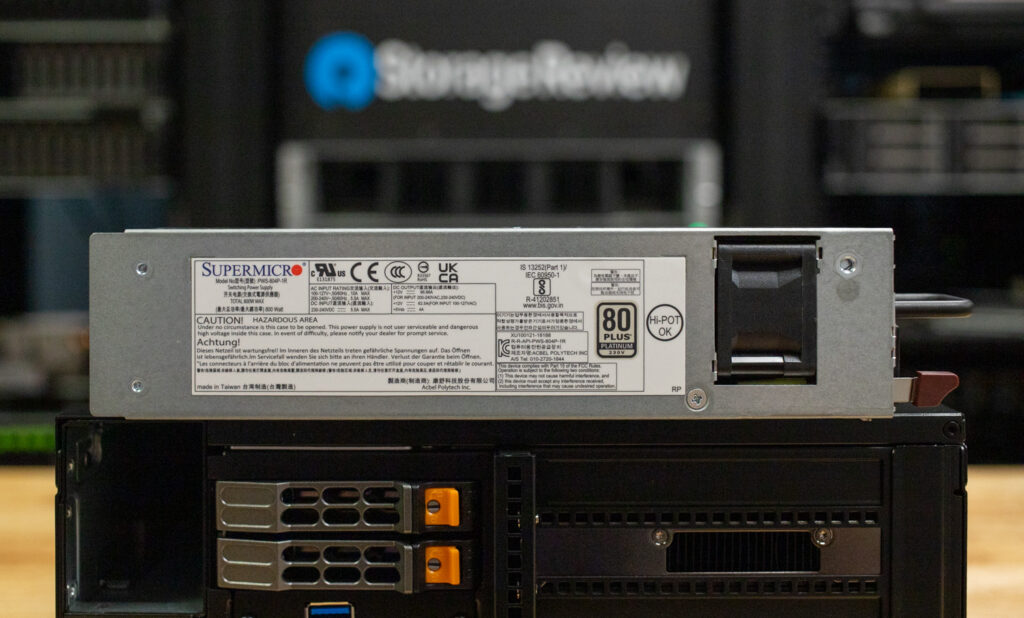
Physically, the design emphasizes quiet operation, front-facing serviceability, and mounting flexibility, with support for wall installations or shallow racks. Rated for operating temperatures up to 45 °C, it is well-suited for deployments in less-controlled environments where traditional rack-mount gear may not be suitable. There are trade-offs, such as the simple U.2 layout rather than denser E3.S options, but this reflects the balance between expandability and keeping the system lean.
Overall, the SYS-E403-14B-FRN2T delivers a unique mix of compact form factor, flexibility, and practical performance. It is not meant to replace high-density rack servers. Still, for organizations that require reliable compute and GPU acceleration at the edge, with simple service and a compact footprint, this system offers a robust and well-thought-out solution.




 Amazon
Amazon